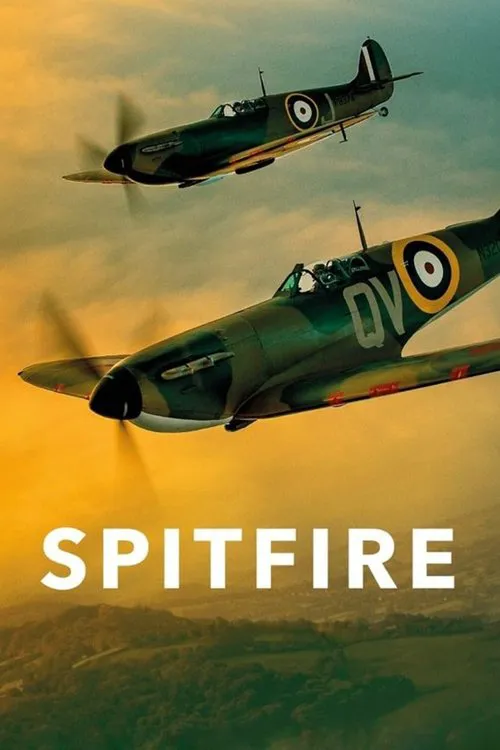Spitfire

Plot
In the early 1930s, the world of aviation was undergoing a period of rapid transformation, driven by the advances in technology and the need for military supremacy. As tensions escalated in Europe, nations began to invest heavily in their air forces, determined to outdo one another in the air. It was in this context that three iconic aircraft would emerge: the Supermarine Spitfire, the Hawker Hurricane, and the Messerschmitt Bf 109. Through the voices of those who lived through these tumultuous times, "Spitfire" tells the story of how these aircraft revolutionized war in the skies. The Spitfire, a sleek and agile fighter born from the drawing boards of R.J. Mitchell and his team at Supermarine, would become synonymous with British aerial prowess. With its elliptical wing design and distinctive Merlin engine, the Spitfire possessed exceptional speed, maneuverability, and firepower. Yet, as the documentary reveals, the Spitfire's journey to becoming a legendary fighter was far from straightforward. The early designs were plagued by technical issues, and it took the determination and expertise of Mitchell and his team to overcome these hurdles. Meanwhile, in the UK, the Hawker Hurricane, another British fighter aircraft, was undergoing its own trials and tribulations. Designed by Sydney Camm and his team at Hawker Aircraft, the Hurricane was initially seen as a lesser aircraft compared to the Spitfire. However, as the documentary shows, the Hurricane's ruggedness, reliability, and sheer weight of production made it a more practical choice for the Royal Air Force (RAF). The Hurricane's underappreciated role in the Battle of Britain would later prove its mettle. In Germany, the Messerschmitt Bf 109, designed by Willy Messerschmitt and his team, embodied the German desire for military dominance. With its impressive speed and maneuverability, the Bf 109 seemed poised to become the Luftwaffe's most formidable asset. Yet, as the documentary reveals, the Bf 109's complex design and production issues would haunt the German air force throughout the war. As the three nations' fighter aircraft took to the skies, their pilots faced treacherous conditions, grueling combat, and the constant threat of death. The documentary follows several pilots, including Robert Stanford Tuck, a British Spitfire pilot, and Adolf Galland, a German Bf 109 ace. Through their voices, the documentary paints a vivid picture of the psychological and physical toll of aerial combat. From the early days of the Spanish Civil War to the Battle of Britain, the Spitfire and Hurricane faced off against their German adversaries. The Luftwaffe's early successes in Poland and France would eventually give way to the devastating losses suffered during the Battle of Britain. The documentary highlights the bravery and skill of the RAF pilots, who, despite being outnumbered and outgunned, managed to hold off the German onslaught. As the war spread across Europe, Africa, and Asia, the Spitfire and its stable-mate, the Hurricane, gained international recognition. From the dusty skies of North Africa to the jungles of Southeast Asia, these aircraft played pivotal roles in shaping the outcome of some of the most significant battles of World War II. Through interviews with those who flew these aircraft, "Spitfire" paints a poignant and often humorous portrait of life in the cockpit. From the intense camaraderie among pilots to the occasional moments of levity, the documentary humanizes the individuals who risked everything to defend their nations and fight for freedom. In the final stages of the war, as the Allies began their push towards victory, the Bf 109's performance began to wane. Overwhelmed by the sheer numbers of Allied aircraft, the Messerschmitt design became increasingly obsolete. As the Luftwaffe's fortunes declined, the Spitfire and Hurricane continued to play key roles in the Allied victory. Throughout the documentary, archival footage and stunning re-enactments bring to life the epic story of these three aircraft. From the factory floors to the cockpit, "Spitfire" reveals the intricate mechanisms that allowed these aircraft to become symbols of their respective countries' pride and determination. As the credits roll, "Spitfire" leaves the viewer with a sense of awe and reverence for the men and women who flew these incredible machines. Through their stories, the documentary reminds us of the sacrifices made during World War II and the profound impact that these aircraft had on the course of history. In the end, "Spitfire" is more than just a documentary about aircraft – it's an homage to the people who built, flew, and fought for these incredible machines. As we reflect on the legacy of the Spitfire, Hurricane, and Bf 109, we are reminded of the enduring power of human innovation and the indomitable spirit of those who risked everything to defend their nations and fight for freedom.
Reviews
Recommendations




